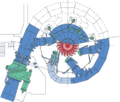Pelton wheel facts for kids
The Pelton wheel or Pelton Turbine is a special type of water turbine. It was invented by an American named Lester Allan Pelton in the 1870s. This turbine gets its power from the push or impulse of moving water. This is different from older water wheels that used the weight of water.
Many water turbines existed before Pelton's design. However, they were not very good at using all the water's energy. Water often left these old wheels still moving fast, wasting a lot of power. Pelton's design was clever. It made the water leave the wheel with very little speed. This meant his turbine captured almost all the water's pushing energy, making it super efficient!
Contents
How the Pelton Wheel Was Invented
Lester Allan Pelton was born in Vermillion, Ohio in 1829. He moved to California in 1850 to join the California Gold Rush. He first earned money by selling fish. Later, in 1860, he moved to Camptonville. This area was a big center for placer mining, which uses water to find gold.
At that time, many mines used steam engines for power. These engines needed huge amounts of wood to burn. Some large water wheels were used in big rivers. But they didn't work well in the smaller streams found near the mines. Pelton started working on a new water wheel design. He wanted one that could use the smaller water flows in these streams.
By the mid-1870s, Pelton had a wooden model of his new wheel. In 1876, he asked the Miners Foundry in Nevada City, California to build the first metal versions. The very first Pelton Wheel was set up at the Mayflower Mine in Nevada City in 1878.
People quickly saw how much better Pelton's invention was. His product became very popular. He officially got a patent for his invention on October 26, 1880. By the mid-1880s, the Miners Foundry couldn't make enough wheels to meet the demand. So, in 1888, Pelton sold the rights to his name and patents. He sold them to the Pelton Water Wheel Company in San Francisco.
The Pelton Water Wheel Company made many Pelton Wheels. They shipped them all over the world. By 1900, more than 11,000 of these turbines were in use. The company kept growing and moved its factory to a larger place in San Francisco in 1914. Later, in 1956, another company bought them, and they stopped making Pelton Wheels.
In New Zealand, a company called A & G Price also made Pelton waterwheels. One of these old wheels is now on display at the Thames Goldmine Experience.
How a Pelton Wheel Works
Imagine a powerful hose spraying water. In a Pelton wheel, special nozzles shoot strong, high-speed streams of water. These water streams hit a series of spoon-shaped buckets. These buckets are also called impulse blades. They are attached around the edge of a large wheel, which is called a runner.
When the water jet hits the buckets, the water's direction changes. It follows the curve of the buckets. The force of the water jet pushes on the buckets and the wheel. This makes the wheel spin. The water then does a "U-turn" inside the bucket. It leaves the bucket from the sides, moving much slower.
This process transfers the water's pushing power to the wheel. This power then makes the turbine work. The wheel spins fastest and most efficiently when its speed is about half the speed of the water jet. This way, the water leaves the wheel with almost no speed left. This means nearly all its energy has been used to spin the wheel.
Usually, two buckets are placed side-by-side on the wheel. The water jet splits into two equal streams to hit them. This helps balance the forces on the wheel. It also makes sure the power transfer from the water to the turbine is smooth and efficient.
Water is very hard to squeeze (incompressible). This means almost all its useful energy is taken out in one go by the Pelton wheel. That's why Pelton wheels only have one set of buckets, unlike some other turbines that use gases.
Where Pelton Wheels Are Used
Pelton wheels are the best choice for making electricity from water (hydro-power) when you have a very high water source but not a huge amount of water flowing. Think of a tall waterfall or a steep mountain stream.
Pelton wheels come in all sizes. Some are huge, weighing many tons. These are used in large hydroelectric plants to make a lot of power. For example, the ones at the Bieudron Hydroelectric Power Station in Switzerland are over 400 megawatts each! That's enough to power many thousands of homes.
The smallest Pelton wheels are just a few inches across. They can be used to get power from small mountain streams. These tiny systems can even use regular household plumbing pipes to deliver water. They work best with a water drop of at least 30 metres (100 ft) to make good power. Pelton wheels generally work well with water drops from 15–1,800 metres (50–5,910 ft), though there's no real upper limit.
System Parts
The pipe that brings high-pressure water to the Pelton wheel is called a penstock. Originally, "penstock" was just the name for a valve. But now, the word is used for the entire system of pipes and controls that carry water under pressure to a turbine.
See also
- Peltric set
- Centrifugal pump
Images for kids





